Every day we read about different crises on our newsfeed. Surely no one expects to wake up one morning and see the name of their company at the headline of one of those articles. But unlike huge corporations, small and medium-size companies are usually not that well-prepared to deal with emergencies.
A crisis can strike an organization like a bolt from the blue. There’s never a good time for it to come, and it will inevitably affect your business, employees, customers and partners. The best way of dealing with a crisis is preventing it, however you might not always be able to avoid it. In order to survive you need to have a well-though crisis management plan, and Microsoft Teams can help you with that.
Resolving a crisis is a collaborative process and it requires involvement of different stakeholders in order to cover the whole scope of the crisis. Therefore many organizations have adopted Teams to improve their collaboration and communication – two indispensable elements of crisis management.
In this article we will demonstrate how you can improve collaboration around crisis management with Microsoft Teams.
Defining Crisis Management
What is crisis?
Business crisis is an emergency situation that disturbs all the individuals across the organization and disrupts normal functioning of the business. It is usually triggered by a series of unexpected events harming organization’s performance.
The problem may occur internally or be caused by external influence. It then escalates to the point where the organization loses control over the situation and has to take timely and efficient measures to address the crisis.
Key characteristics of a business crisis:
- Usually comes abruptly and unexpectedly
- Poses a threat to organization’s activities
- Requires an immediate response
A crisis can take many forms, such as natural disasters, fires, or – as it is the case with our extraordinary times – a global pandemic coupled with political demonstrations; and more common situations such as bankruptcy, data breach, technology crash, scandals involving senior management and others.
What is crisis management?
It is always better to be prepared for a crisis. The organization should have a plan for any possible worst-case scenario. And this is where crisis management comes in.
Crisis management is a process of preparing for and dealing with any abrupt and unexpected situations affecting the organization, its employees, management, as well as external stakeholders.
According to Inc. Magazine for growing companies, there are 7 key steps for effective crisis management.
1. Create a plan
Define your objectives during the crisis (for instance: to protect the employees, to ensure organization’s functionality and to keep all the stakeholders informed) and create an action plan with specific step that the organization will take in case of a crisis.
2. Assign a spokesperson
Depending on the scale of the crisis and its impact on the public, the crisis might get attract attention of the media. Choose the right person to represent your company and deliver a clear consistent message. Prepare them for answering questions from media and make sure this person is well-informed about the situation.
3. Be transparent
Be as open and transparent with the media and the public as possible. Suspicion of dishonesty will only generate rumors and do more harm to your company. Make sure that you are the source of information in the event of the crisis and communicate with the people through all available communication channels.
4. Keep your staff up-to-date
In order to avoid misinformation and internal rumors, keep your staff informed about the course of the crisis. Thus, you will ensure your organization runs more smoothly in spite of the challenging situation that it’s facing.
5. Communicate with all the stakeholders
Make sure your partners, clients and other external stakeholder learn about the crisis situation directly from you. Update them about your course of action in order to keep their trust and continue your collaboration with them.
6. Give regular updates
You want to communicate about the crisis as early and as often is possible. In the emergency situation it’s better to overdo it rather than stay quiet. Issue emergency statements, action plans, talk about new developments and updates. Try to fill the information void with your messaging to avoid any rumors.
7. Use social media
Social media has become one of the most popular news platforms. Monitor what kind of information is published on popular social media pages, track reactions and shares and respond accordingly.
And of course, while developing your Crisis management plan, make sure to consult leading experts in your organization from different areas of expertise in order to cover all the possible scenarios.
Example
To give an idea of how crisis management works, let’s take an example of a labor crisis – a strike. How will your crisis management team deal with this situation?
First of all, in order to be prepared for this type of crisis they need to be properly trained and educated on how to communicate with strikers. Your team should include members of senior management and a labor attorney to efficiently deal with workers’ demands.
Your crisis management team should also have already prepared guide with worst-case scenarios and a protocol to follow.
If your organization got attention from the media, it is a good practice to assign a spokesperson that will represent the company and organize a press-conference, inviting different media, or an interview. This will help avoid rumors and ensure that your organization is the primary source of information on the crisis.
The use of social media can also be included into the crisis management plan as it will ensure prompt and live communication.

Collaboration challenges in Crisis Management
Dealing with a crisis is never a one person’s job. A whole crisis management team is required, that will consist of a leader and representatives of different areas withing the organization. Their responsibility is to gather all the information regarding their area and the effects of the crisis on it, and then prioritize different actions.
All this requires smooth and efficient collaboration which many companies are struggling with. Here are some of the common collaboration challenges in crisis communication:
Limited joint situation awareness
It sometimes happens that different members of the crisis management team are not equally informed about the situation, and therefore cannot take effective joint actions. This happens as a result of poor communication between team members and/or inefficient collaboration tools that do not allow teams to share information freely.
Lack of coordination
Any crisis is always sudden and abrupt, which is why some companies struggle to coordinate their actions in effective and timely manner. It is very important, however, for every individual in the crisis management team to know exactly what their responsibilities are. Coordinated actions will smoothen the way out of the crisis and make it much quicker and efficient.
Lack of standardized procedures
Another common problem is lack of unified course of action. When a crisis strikes, many companies react on the spot without following standardized procedures. It’s important to create a guide with a clear plan of action for your crisis management team to follow in case of a crisis.
Inefficient information sharing
Overload of repetitive information shared by different team members, lack of information sharing, over and above done in untimely manner can significantly slow down the way out of crisis.
Inadequate training
Crisis resolution requires preparation. And it goes beyond creating a guide or action plan for all the possible worst-case scenarios. Your team has to be trained for an emergency. The training includes planning for crises, responding to emergencies and natural disasters as well as media inquiries.
However, all of these issues can be resolved if you use the right tools for collaboration around crisis management communication.
How to use Microsoft Teams in Crisis Management?
Microsoft Teams is made for fostering teamwork through different capabilities. For you Crisis Management team, you can improve your communication and collaboration by sharing files, working together on the documents, navigating through different apps right in the Teams environment, as well as messaging and calling.
Let us demonstrate you how with Microsoft Teams you can improve your Crisis Management collaboration.
Crisis Management team in Microsoft Teams
Create a team
Build a Crisis Management team, write a description explaining the purpose of the team, and add your employees.
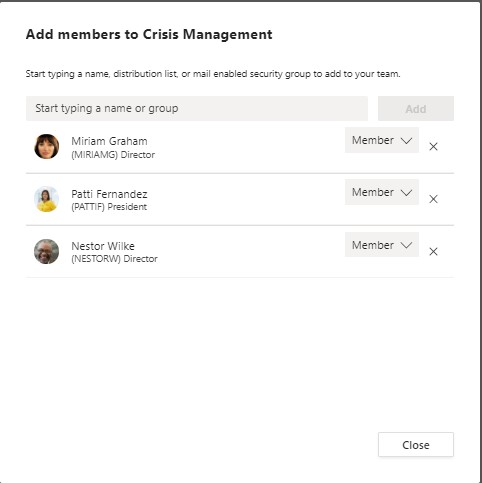
Create channels
Effective crisis management requires implementation of a series of actions from different stakeholders. Create relevant channels for specific groups of the team, such as:
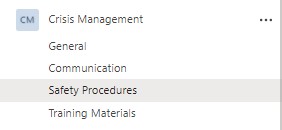
Training Materials – where you will share with your staff all the resources for crisis preparation and readiness.
Communication – for making important announcements and keeping your team up to date.
Safety Procedures – communicate with your stuff about specific measures that they should take in case of emergency.
You can restrict access to certain channels only to specific group members through membership and ownership settings.
Add tabs with files and apps

You can add crisis management apps and important files as tabs in your team. This way you can make sure your team will have easy access to important information while staying in the Teams environment.
Build a Crisis management guideline from intranet
In Microsoft Teams you can build a Crisis management guideline that everyone in your organization will have access to and will be able to follow in case of emergency. Plan out crisis scenarios and create a list of standardized procedures to include in your guideline.

Chat that works well for Crisis Management
Urgent Notification
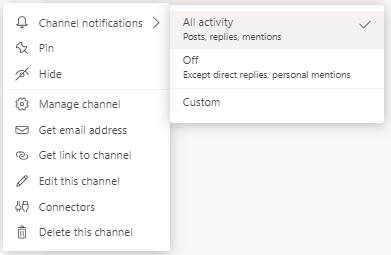
Instruct your employees to turn on notifications for the channels where you share urgent information.
In the settings of the right channel, choose Channel notifications and select All activity. This way, all your team will receive a notification of any new posts created in that channel as if they were tagged.
Additionally, they will get notifications for all replies to conversations.
Picture with annotation
In order to pay your team’s attention to the most important crisis news, use Announcement feature for your post. It allows you to write a headline to your message and use a background image or add color, highlighting the important information.

Location sharing
Microsoft Teams also allows you to share location with your team through a mobile device. This feature can be useful in case of emergency such as natural disaster or fire in the office. In order to enable this feature, you need to:

- Click on the ‘+’ in the ‘Type message’ options, to open the ‘more options’ menu.
- Select ‘Location’.
- Teams will automatically mark your physical location, but you can change it to a specific address (you need to grant permission to Microsoft Teams to use your location).
- Click on ‘Share Location’.

Calling and video conferencing
And of course, with Microsoft Teams you can always stay in touch with your colleagues not only through messaging, but also through audio and video calls. This can be especially topical during an emergency to ensure everyone’s safety.
You can organize a call with your crisis management teams as well as create a live event inviting all the members of your organization.
You are also able to invite external members to your conferencing by sending them an invitation.
How to improve your Crisis Management process with Microsoft Teams Templates
We know how important it is in Crisis Management not to waste time on repetitive tasks and have a strong organizational structure.
Some organizations have to address hundreds of crises (of different scale, of course) each year. Creating a new team each time when yet another crisis occurs creates huge working load for the IT team and slows down the crisis management process. And can bring inconsistency to the process execution from one crisis to another.
However, you can improve your collaboration processes in Teams through Templates.
Native capabilities of Templates by Microsoft
With Microsoft Templates, you will be able to use a base template and then modify it according to your business needs. You may include different channels and apps that will be cloned to your future teams created from this template.
However, Templates by Microsoft Teams do not address common IT issues around governance and maintenance. For this reason, many organizations look for more advanced solutions to empower their use of Teams.
Advanced Templates by SalesTim
At SalesTim, we created a Templates technology that will help you create a template dedicated to Crisis Management that will correspond to both your business and IT needs.
How to use Crisis Management template for end-users:
1. Click on ‘New team’
2. Choose the ‘Crisis Management’ template
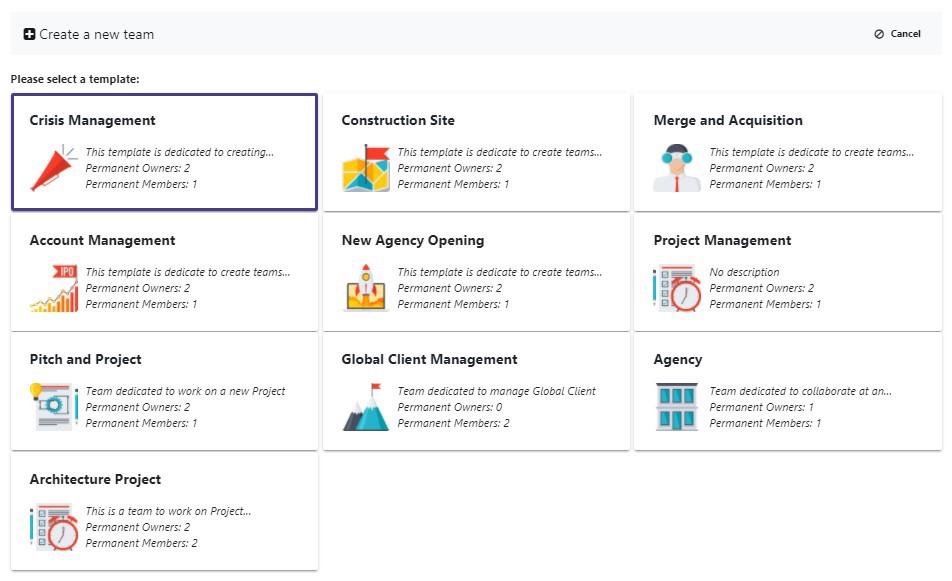
3. Give it a name, description and write a welcome message
4. Add owners and members

5. Click on ‘Send’.

It’s done! Now you have to either wait for approval of your team, or start working on it straight away, depending on you organization’s governance policies.
How to create a template:
1. Create the original Crisis Management team that you will use as a template.
2. Add Channels for different purposes of your crisis management (for example Budget, Training Materials, Communication, Executive reviews, Planning, etc.)
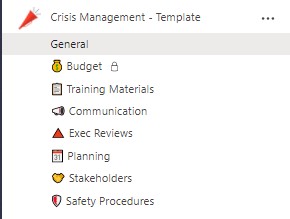
3. Set up relevant apps, e.g. planner with tasks, and your crisis management files (protocols, guidelines) as tabs in your team.

4. In the SalesTim Catalog click on ‘New template’ and choose the Crisis Management – Templates team that you just created.
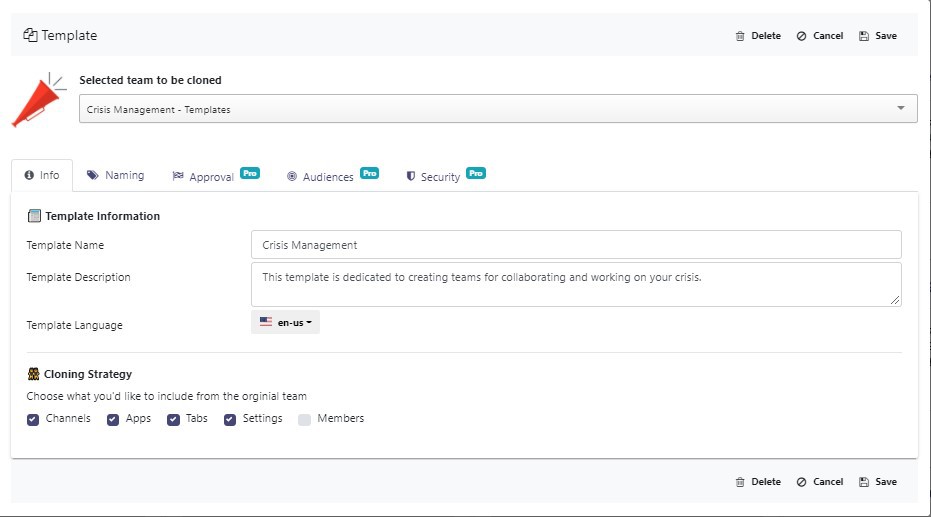
6. Set up your team’s Naming Convention according to your business needs. You can structure it with regards to company’s name, location, department, employee ID, etc.

7. Enable Approval workflow, then assign a person or people who will deal with teams’ creation requests.
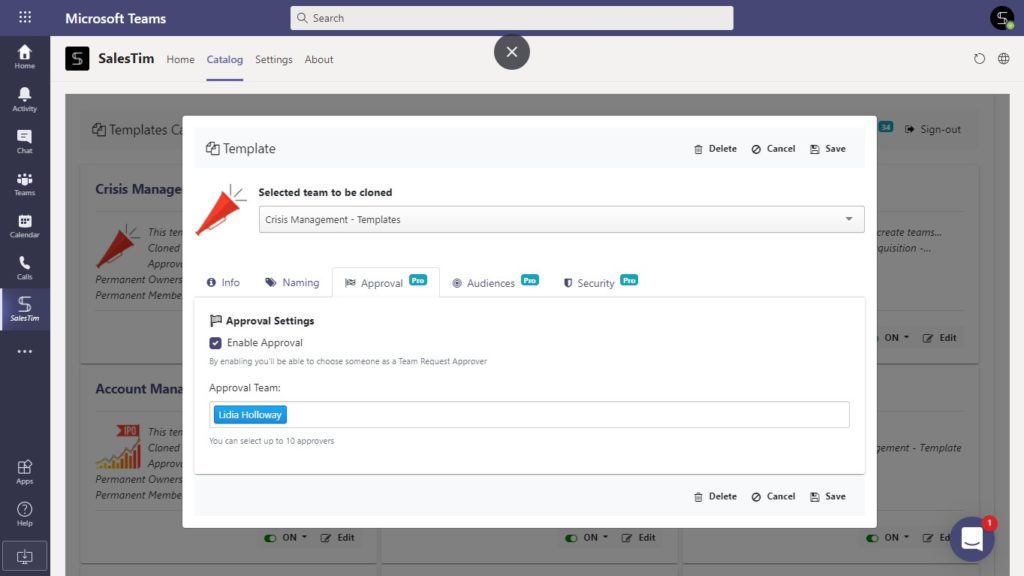
8. Decide who can see your template through Audience Targeting.
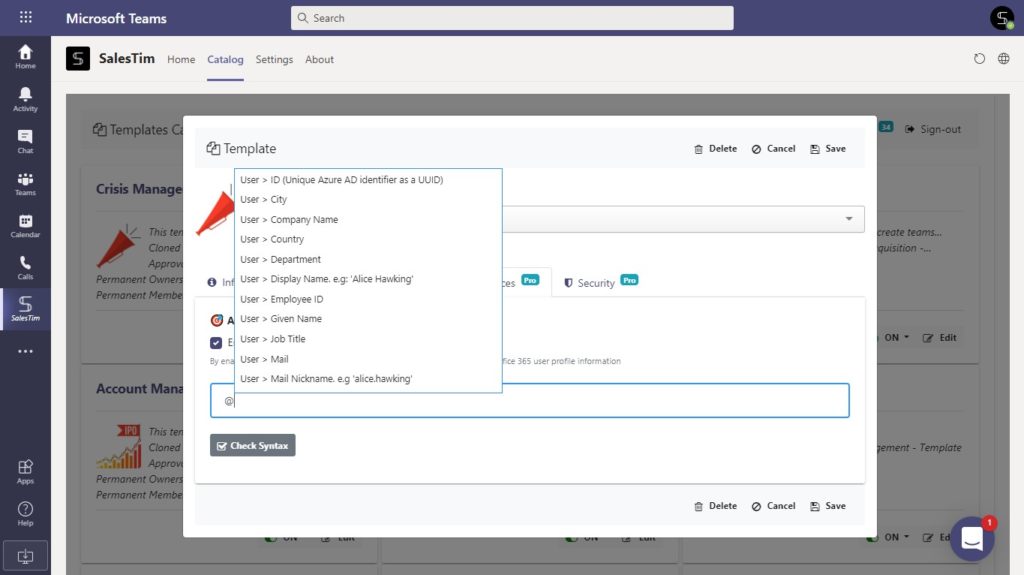
9. Set up privacy and security settings and determine Permanent Owners and Members.
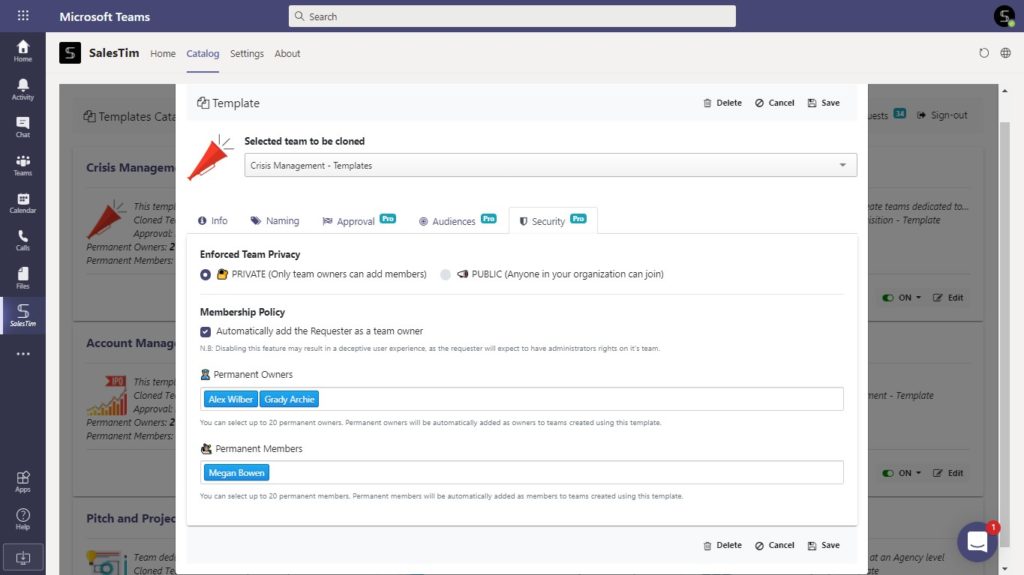
Your template is created!
All the teams that you create from this template will have the same structure and rest assured that all the apps, tabs and documents will be automatically cloned.
Crisis management is a complex process that requires preparation, training, thorough analysis and prompt decision-making. One never knows when the next crisis strikes, so you and your team should always be ready to act fast and efficiently.
In this article we shared with you how you can improve collaborative processes around crisis communication with Microsoft Teams.
We would love to hear your stories! So don’t hesitate to contact us and share your experience using Teams.
Stay tuned and don’t miss our next articles:)
